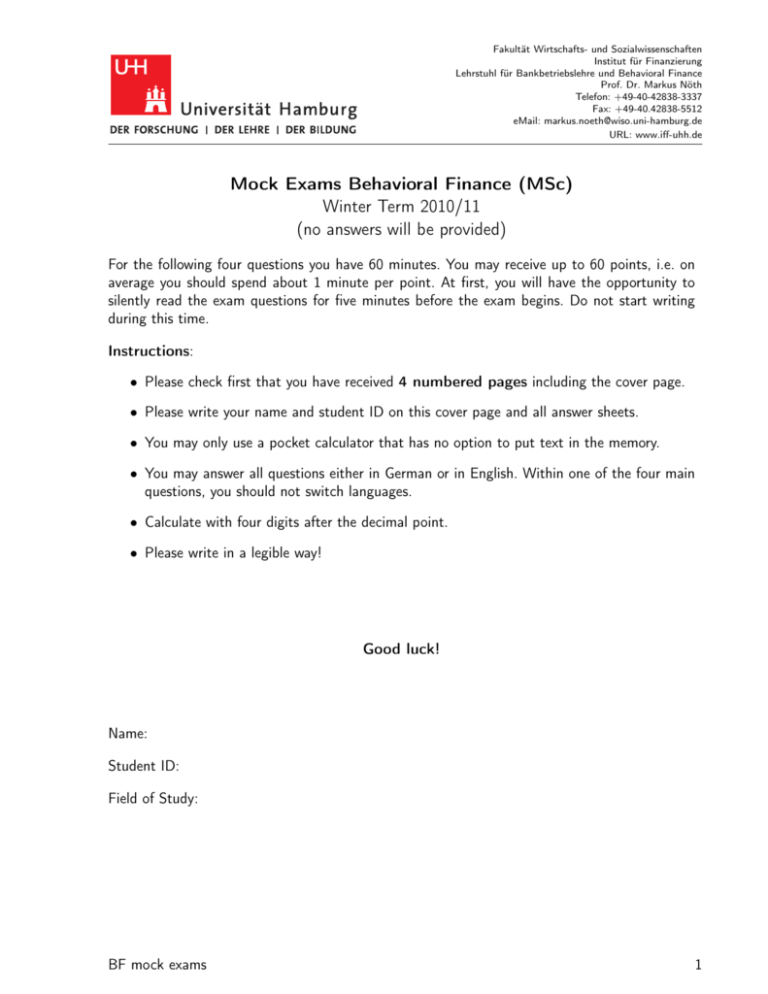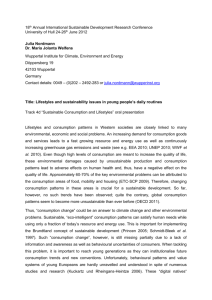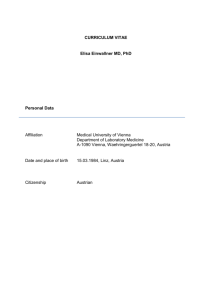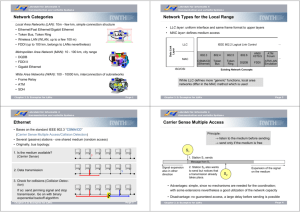Mock Exams Behavioral Finance - Lehrstuhl für Bankbetriebslehre
advertisement

Fakultät Wirtschafts- und Sozialwissenschaften Institut für Finanzierung Lehrstuhl für Bankbetriebslehre und Behavioral Finance Prof. Dr. Markus Nöth Telefon: +49-40-42838-3337 Fax: +49-40.42838-5512 eMail: markus.noeth@wiso.uni-hamburg.de URL: www.iff-uhh.de Mock Exams Behavioral Finance (MSc) Winter Term 2010/11 (no answers will be provided) For the following four questions you have 60 minutes. You may receive up to 60 points, i.e. on average you should spend about 1 minute per point. At first, you will have the opportunity to silently read the exam questions for five minutes before the exam begins. Do not start writing during this time. Instructions: • Please check first that you have received 4 numbered pages including the cover page. • Please write your name and student ID on this cover page and all answer sheets. • You may only use a pocket calculator that has no option to put text in the memory. • You may answer all questions either in German or in English. Within one of the four main questions, you should not switch languages. • Calculate with four digits after the decimal point. • Please write in a legible way! Good luck! Name: Student ID: Field of Study: BF mock exams 1 Fakultät Wirtschafts- und Sozialwissenschaften Institut für Finanzierung Lehrstuhl für Bankbetriebslehre und Behavioral Finance Prof. Dr. Markus Nöth Telefon: +49-40-42838-3337 Fax: +49-40.42838-5512 eMail: markus.noeth@wiso.uni-hamburg.de URL: www.iff-uhh.de 1. Bayesian Updating (a) What are informational cascades? You may use an example, too. 15 points (2 points) (b) Why can the observed error rates at position I (θ, ) not explain the predictions at position II (A1 , bw )? Why does the underlying assumption imply overconfidence? (5 points) (c) Sequential decision making – prediction of A or B: • • • • • p(A) = 1 − p(B) = 0.6 p(a|A) = 0.7 = 1 − p(b|A) p(b|B) = 0.8 = 1 − p(a|B) position I: p(A|a) =? ∧ p(B|b) =? position II: p(A|A1 , b) =? ∧ p(B|B1 , a) =? ⇒ Please provide the prediction in all four situations as well. (8 points) 2. Judgement biases (a) Please define and explain anchoring and adjustment effects. 15 points 3 points (b) What is loss aversion? Please explain why loss aversion can explain behavior with respect to the Samuelson lottery. 2 points (c) Please define the disposition effect. Explain its relation to the prospect theory. 5 points (d) Please explain how Weber/Camerer (1998) try to control for the disposition effect. Explain also whether and why their approach is effective or ineffective. 5 points BF mock exams 2 Fakultät Wirtschafts- und Sozialwissenschaften Institut für Finanzierung Lehrstuhl für Bankbetriebslehre und Behavioral Finance Prof. Dr. Markus Nöth Telefon: +49-40-42838-3337 Fax: +49-40.42838-5512 eMail: markus.noeth@wiso.uni-hamburg.de URL: www.iff-uhh.de 3. Overreaction: DeBondt/Thaler JF 1985/87 15 points source: DeBondt & Thaler (1987), average monthly excess returns of winners & losers, table 1, p. 561 (a) Describe the trading strategy and how the portfolios are constructed. 6 points (b) Describe the main results for winners and losers (all months/January ) (see table). 5 points (c) Why are zero-cost portfolios not necessarily zero-beta portfolios? BF mock exams 4 points 3 Fakultät Wirtschafts- und Sozialwissenschaften Institut für Finanzierung Lehrstuhl für Bankbetriebslehre und Behavioral Finance Prof. Dr. Markus Nöth Telefon: +49-40-42838-3337 Fax: +49-40.42838-5512 eMail: markus.noeth@wiso.uni-hamburg.de URL: www.iff-uhh.de 4. Soft Paternalism: Benartzi/Thaler JPE 2004 S182 points journal of political 15 economy TABLE 6 Median Income Replacement Ratios (%) Age Income 25 35 45 55 A. Pre-SMarT $25,000 $50,000 $75,000 57 51 48 57 51 49 56 51 46 55 54 43 B. Post-SMarT $25,000 $50,000 $75,000 108 98 90 90 83 77 75 70 63 63 62 50 Note.—The table displays the median income replacement ratios for different age and income profiles, using investment advice software by Financial Engines. The projections are based on the following assumptions: no defined-benefit pension, statutory social security benefits, employee saving rate of 4 percent before SMarT and 14 percent thereafter, employer match of 50 cents on the dollar up to 6 percent, portfolio mix of 60 percent stocks and 40 percent bonds, and retirement age of 65. Thaler/Benartzi (2004): Table 6, p. S182. 43 and 57 percent. Replacement rates are highest for the $25,000 in(a) Please describe the mainsocial goal and the mainoffers featuressubstantial of the SMarT replacement program. come category because security at 5 points that level. Panel B shows that replacement income rates are considerably higher with the especially for those joining the plan when (b) Describe and SMarT explain theplan, main result of the SMarT program. 5 points young. Obviously, increasing the savings rate is less effective when one (c) Describe and explain the Median Income Replacement Ratios for different age and starts income at 55 groups. than What at 25. Still, expected replacement rates exceed 100 are the main effects (see table)? 5 points percent in just one cell (108 percent replacement for those making $25,000 per year who join the plan at age 25), so there does not appear to be evidence that we have induced people to save too much. Furthermore, if the stock market returns are exceptionally high, workers nearing retirement can always reduce savings rates or plan an earlier retirement if they have higher retirement benefits than they expected. V. The Potential Effect of SMarT on the U.S. Personal Savings Rate BF The mock U.S. exams personal 4 savings rate is currently close to zero. Some macro- Fakultät Wirtschafts- und Sozialwissenschaften Institut für Finanzierung Lehrstuhl für Bankbetriebslehre und Behavioral Finance Prof. Dr. Markus Nöth Telefon: +49-40-42838-3337 Fax: +49-40.42838-5512 eMail: markus.noeth@wiso.uni-hamburg.de URL: www.iff-uhh.de solution for question 1c Sequential decision making – prediction of A or B: • p(A) = 1 − p(B) = 0.6 • p(a|A) = 0.7 = 1 − p(b|A) • p(b|B) = 0.8 = 1 − p(a|B) • position I: p(A|a) =? ∧ p(B|b) =? • position II: p(A|A1 , b) =? ∧ p(B|B1 , a) =? ⇒ Please provide the prediction in all four situations as well. p(A|a) = 0.6∗0.7 0.6∗0.7+0.4∗0.2 = 0.84 = p(A|A1 ) > 0.6 = p(A) ⇒ A p(B|b) = 0.4∗0.8 0.4∗0.8+0.6∗0.3 = 0.64 = p(B|B1 ) > 0.4 = p(B) ⇒ B p(A|A1 , b) = 0.6∗0.3∗0.84 0.6∗0.3∗0.84+0.4∗0.8∗0.16 = 0.747 ⇒ A p(B|B1 , a) = 0.4∗0.2∗0.64 0.4∗0.2∗0.64+0.6∗0.7∗0.36 = 0.253 = 1 − p(A|B1 , a) ⇒ A (Note that p(A|B1 , a) = 0.747 > 0.6) also useful: 0.6∗0.3 = 0.36 = p(A|B1 ) p(A|b) = 0.6∗0.3+0.4∗0.8 p(B|a) = 0.4∗0.2 0.4∗0.2+0.6∗0.7 BF mock exams = 0.16 = p(B|A1 ) 5









